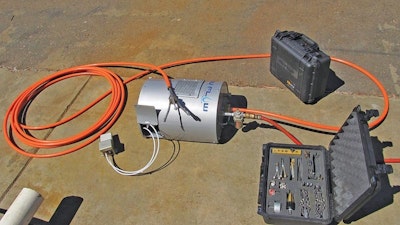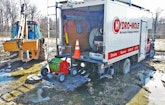Interested in Manholes?
Get Manholes articles, news and videos right in your inbox! Sign up now.
Manholes + Get AlertsRegular maintenance with root herbicide reduces sewer overflows
Problem: The City of Virginia Beach, Virginia, located at the mouth of the Chesapeake Bay, has little topographical relief and a multitude of pumping stations to convey flow from its customers to the local treatment facilities. Under Special Order by Consent, Virginia Beach was ordered to reduce sanitary sewer overflows, rehabilitate its sanitary sewer system, reduce inflow and infiltration, and make long-term improvements to improve capacity.
Solution: Brown and Caldwell identified grease and roots as the primary causes of SSOs. They incorporated a proactive MOM (management, operation, maintenance) program, which included product and services from Duke’s Root Control to keep the sewers root-free, reduce I&I and improve capacity. Razorooter II diquat-based herbicide is registered by the EPA for controlling nuisance tree roots in sanitary sewer collections systems and received a classification of “evidence of non-carcinogenicity in humans.”
Result: The city noted that after the first year of the formal root control program, the number of SSOs dropped over 30 percent and have continued to drop substantially ever since. The city also noticed an instantaneous return on its investment via reduced frequency of SSOs after implementation of the MOM program, of which root control was an important part. 800/447-6687; www.dukes.com.
Cutter used to remove roots from clogged clay sewer line
Problem: A camera inspection revealed that backups at a residence in the Hidden Valley neighborhood of La Jolla, California, were caused by heavy root intrusion in the line. Roots from nearby trees grew into the joints and cracks, blocking sanitary waste from traveling. The pipes ran under hilly terrain from the home’s clean-out in the yard to the city’s main sewer line. Not only were the pipes located 6 to 9 feet below grass and trees in the customer’s yard, but also in the neighbor’s yard.
Solution: Using the Micro-Cutter, a technician from Nu Flow America was able to clean more than 200 feet of 4-inch clay sewer pipe. The system rotates at approximately 2,000 rpm and will negotiate turns of 90 degrees in pipes down to 2 inches in diameter. It runs at 40 cfm and allows for multiple cutting heads to be attached.
Result: The technician successfully cleaned the root-infested sewer line using existing access points, without the need to dig up the customer’s or the neighbor’s property. He then installed the Nu Drain Pull-in-Place structural liner to prevent future root intrusion. 905/433-5510; www.nuflowtech.com.
Controlled-rotation jetting nozzle effective in opening pipe at treatment facility
Problem: Rodney King, proprietor of Hydro-Mole mechanical cleaning company specializing in coil cleaning, hydro jetting and CCTV pipe inspections, recently received a call from the nearby City of Hurst, Illinois, about a blocked pipe at its sewer treatment facility. Prior to arriving at the site, King was informed by the sewer treatment plant operator that the treatment ponds were overflowing due to the apparent blockage. Two jet trucks from other neighboring municipalities were already on the scene but had been unsuccessful in opening the pipe.
Solution: “Upon setting up, I selected our WH-1/2 nozzle,” King recalls. The Warthog WH-1/2 from StoneAge is a controlled-rotation jetting nozzle for 6- to 18-inch lines most commonly used with small-capacity combination trucks and large trailer jetters. It maximizes cleaning power into as few jets as possible to efficiently penetrate blockages, cut roots and clean walls.
Result: “After running our machine for five minutes, the pipe began to flow,” King says. “The 10-foot manhole that we were jetting from started overflowing within 45 seconds.” 866/795-1586; www.sewernozzles.com.








